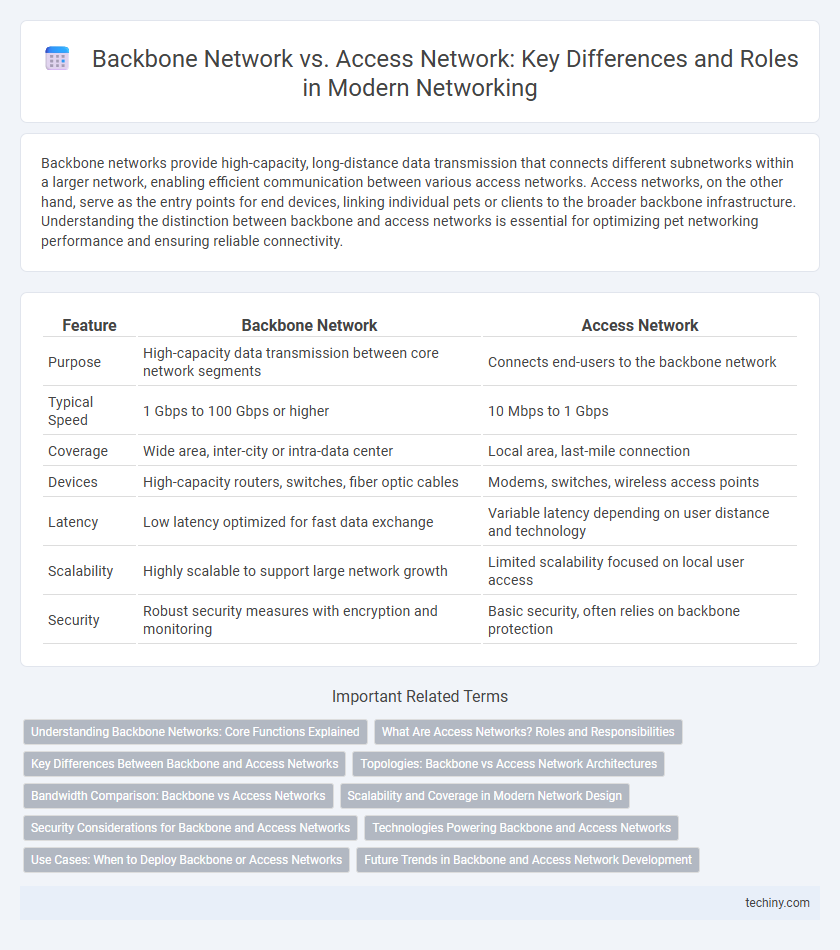Backbone networks provide high-capacity, long-distance data transmission that connects different subnetworks within a larger network, enabling efficient communication between various access networks. Access networks, on the other hand, serve as the entry points for end devices, linking individual pets or clients to the broader backbone infrastructure. Understanding the distinction between backbone and access networks is essential for optimizing pet networking performance and ensuring reliable connectivity.
Table of Comparison
| Feature | Backbone Network | Access Network |
|---|---|---|
| Purpose | High-capacity data transmission between core network segments | Connects end-users to the backbone network |
| Typical Speed | 1 Gbps to 100 Gbps or higher | 10 Mbps to 1 Gbps |
| Coverage | Wide area, inter-city or intra-data center | Local area, last-mile connection |
| Devices | High-capacity routers, switches, fiber optic cables | Modems, switches, wireless access points |
| Latency | Low latency optimized for fast data exchange | Variable latency depending on user distance and technology |
| Scalability | Highly scalable to support large network growth | Limited scalability focused on local user access |
| Security | Robust security measures with encryption and monitoring | Basic security, often relies on backbone protection |
Understanding Backbone Networks: Core Functions Explained
Backbone networks serve as the primary data routes connecting various subnetworks and large-scale systems, ensuring high-speed, reliable data transmission across extensive geographic areas. They manage core functions such as traffic aggregation, protocol translation, and fault tolerance to maintain efficient network communication. Unlike access networks that link end devices to the backbone, backbone networks provide the critical infrastructure backbone supporting enterprise, ISPs, and data center connectivity.
What Are Access Networks? Roles and Responsibilities
Access networks serve as the crucial link between end-user devices and the core backbone network, facilitating data transmission within local or metropolitan areas. Their primary roles include providing reliable connectivity, managing bandwidth allocation, and ensuring security protocols to support user access to network services. These networks encompass various technologies such as DSL, fiber optics, and wireless connections, which optimize data delivery and interface with the broader backbone infrastructure.
Key Differences Between Backbone and Access Networks
Backbone networks feature high-capacity, high-speed data transmission infrastructure designed to connect multiple access networks and carry aggregated traffic across large geographic areas, using fiber-optic cables and core routers. In contrast, access networks provide the initial point of connection for end-user devices, typically utilizing lower-speed connections like Ethernet or wireless links to deliver services within localized areas such as homes or businesses. Key differences include their roles in the network hierarchy, bandwidth capacity, and geographical scope, with backbone networks supporting extensive data transfer across wide areas, while access networks focus on localized connectivity and user access.
Topologies: Backbone vs Access Network Architectures
Backbone networks typically utilize a mesh or ring topology to ensure high reliability and fault tolerance by connecting multiple network segments and core routers. In contrast, access networks often adopt star or tree topologies, focusing on connecting end-user devices to the backbone with simplified layout and scalability. The choice of topology directly impacts network performance, redundancy, and management complexity in both backbone and access network architectures.
Bandwidth Comparison: Backbone vs Access Networks
Backbone networks typically offer significantly higher bandwidth capacities, ranging from 10 Gbps to several terabits per second, ensuring robust data transfer across core infrastructure. Access networks, in contrast, provide lower bandwidths, often between 100 Mbps and 1 Gbps, optimized for end-user connectivity and local distribution. The disparity in bandwidth reflects the backbone's role in aggregating traffic from multiple access networks and supporting large-scale data transmission demands.
Scalability and Coverage in Modern Network Design
Backbone networks provide high-capacity data transport with extensive coverage, enabling scalable infrastructure that supports rapid growth and heavy traffic loads across wide geographic areas. Access networks focus on connecting end-users to the backbone, optimizing local coverage and device accessibility but often face limitations in scalability due to bandwidth and technology constraints. Modern network design leverages hierarchical architectures where scalable backbone networks ensure robust performance while flexible access networks adapt to diverse user density and coverage demands.
Security Considerations for Backbone and Access Networks
Backbone networks require robust security measures such as encryption, access control lists, and intrusion detection systems to protect high-capacity data transmission and prevent widespread breaches. Access networks face vulnerabilities from numerous endpoints, making strong authentication, endpoint security, and regular patch management critical to mitigate risks posed by user devices and external attacks. Implementing segmented network architectures and continuous monitoring enhances security posture across both backbone and access layers, ensuring data integrity and minimizing attack surfaces.
Technologies Powering Backbone and Access Networks
Fiber optic cables and high-capacity routers power backbone networks, enabling fast, reliable data transmission across long distances. Access networks rely on technologies such as DSL, cable, fiber-to-the-home (FTTH), and wireless access points to connect end-users to the backbone, providing localized connectivity. The integration of Multiprotocol Label Switching (MPLS) in backbone networks enhances traffic management, while Gigabit Ethernet and Wi-Fi 6 optimize access network performance.
Use Cases: When to Deploy Backbone or Access Networks
Backbone networks are deployed to connect multiple access networks, supporting high-capacity data transfer for large-scale enterprise environments, data centers, and internet service providers. Access networks are implemented to provide end-user connectivity, typically in residential neighborhoods, office buildings, and small business locations where direct device or client access is essential. Choosing between backbone and access networks depends on the need for scalable infrastructure supporting broad data routing versus localized user endpoint connectivity.
Future Trends in Backbone and Access Network Development
Emerging trends in backbone network development emphasize higher-capacity optical fiber technologies and the integration of AI-driven traffic management for enhanced efficiency and scalability. Future access networks prioritize 5G and beyond, leveraging edge computing and network slicing to deliver ultra-low latency and customized services. The convergence of these advancements accelerates the deployment of smart cities and IoT ecosystems, driving demand for robust, flexible infrastructure.
Backbone Network vs Access Network Infographic

 techiny.com
techiny.com